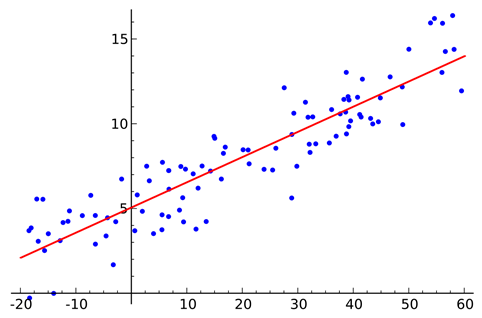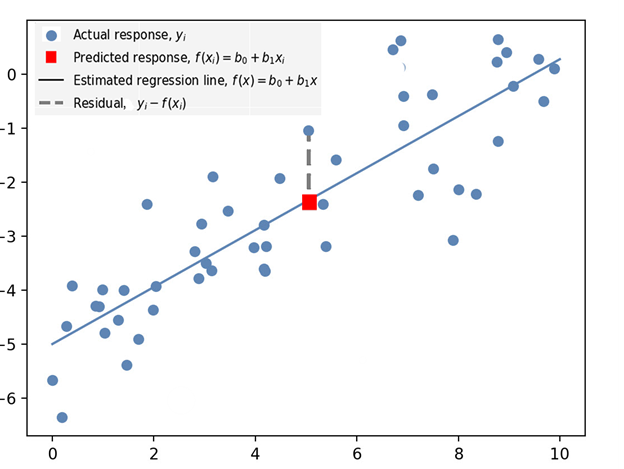What Is Machine Learning Python
Scikit-learn is a Python packet that simplifies the implementation of a wide range of Car Learning (ML) methods for predictive information analysis, including linear regression.
Linear regression can be thought of equally finding the directly line that all-time fits a ready of scattered data points:

Y'all can then project that line to predict new information points. Linear regression is a cardinal ML algorithm due to its comparatively simple and core properties.
Linear Regression Concepts
A basic agreement of statistical math is primal to comprehending linear regression, as is a good grounding in ML concepts.
For more information on ML concepts and terminology, refer to: What is Scikit-Larn In Python?
The following are some central concepts you will come beyond when you work with scikit-larn's linear regression method:
- Best Fit – the direct line in a plot that minimizes the departure between related scattered data points.
- Coefficient – also known every bit a parameter, is the cistron a variable is multiplied by. In linear regression, a coefficient represents changes in a Response Variable (come across below).
- Coefficient of Conclusion – the correlation coefficient denoted as 𝑅². Used to describe the precision or caste of fit in a regression.
- Correlation – the human relationship betwixt two variables in terms of quantifiable strength and degree, often referred to as the 'caste of correlation'. Values range betwixt -ane.0 and i.0.
- Dependent Feature – a variable denoted equally y in the slope equation y=ax+b . Also known as an Output, or a Response.
- Estimated Regression Line – the straight line that all-time fits a set up of scattered information points.
- Contained Feature – a variable denoted as x in the slope equation y=ax+b . Also known as an Input, or a predictor.
- Intercept – the location where the Slope intercepts the Y-axis denoted b in the slope equation y=ax+b.
- Least Squares – a method of estimating a Best Fit to data, past minimizing the sum of the squares of the differences betwixt observed and estimated values.
- Hateful – an av erage of a set of numbers, but in linear regression, Hateful is modeled past a linear part.
- Ordinary Least Squares Regression (OLS) – more than commonly known as Linear Regression.
- Residuum – vertical distance between a data indicate and the line of regression (encounter Balance in Figure i below).
- Regression – estimate of predictive change in a variable in relation to changes in other variables (run into Predicted Response in Effigy i below).
- Regression Model – the ideal formula for approximating a regression.
- Response Variables – includes both the Predicted Response (the value predicted past the regression) and the Actual Response, which is the bodily value of the data point (see Effigy 1 beneath).
- Slope – the steepness of a line of regression. Slope and Intercept can be used to ascertain the linear relationship betwixt ii variables: y=ax+b.
- Elementary Linear Regression – a linear regression that has a single independent variable.
Figure one. Illustration of some of the concepts and terminology defined in the above department, and used in linear regression:
Linear Regression Course Definition
A scikit-learn linear regression script begins by importing the LinearRegression grade:
from sklearn.linear_model import LinearRegression sklearn.linear_model.LinearRegression()
Although the class is not visible in the script, it contains default parameters that do the heavy lifting for simple to the lowest degree squares linear regression:
sklearn.linear_model.LinearRegression(fit_intercept=True, normalize=Faux, copy_X=True)
Parameters :
-
fit_interceptbool, default=True
Calculate the intercept for the model. If set to Fake, no intercept will exist used in the calculation.
-
normalizebool, default=Simulated
Converts an input value to a boolean.
-
copy_Xbool, default=True
Copies the Ten value. If True, 10 will be copied; else it may be overwritten.
How to Create a Linear Regression Model
In this example, a linear regression model is created based on data in a numpy assortment. The coefficients are formulated and then printed in the console:
# Import the packages and classes needed in this case: import numpy as np from sklearn.linear_model import LinearRegression # Create a numpy assortment of data: x = np.assortment([vi, 16, 26, 36, 46, 56]).reshape((-1, 1)) y = np.array([iv, 23, x, 12, 22, 35]) # Create an instance of a linear regression model and fit information technology to the data with the fit() function: model = LinearRegression().fit(x, y) # The post-obit section will get results by interpreting the created instance: # Obtain the coefficient of conclusion by calling the model with the score() function, then print the coefficient: r_sq = model.score(x, y) print('coefficient of determination:', r_sq) # Print the Intercept: print('intercept:', model.intercept_) # Print the Slope: impress('slope:', model.coef_) # Predict a Response and print it: y_pred = model.predict(ten) print('Predicted response:', y_pred, sep='\north') Lookout man how to create a Linear Regression and then print the Coefficients
How to Create a Linear Regression and Display it
In this example, random data is displayed in a plot. A linear regression model is then created against the data, and an estimated regression line is finally displayed.
# Import the packages and classes needed for this example: import numpy equally np import matplotlib.pyplot as plt from sklearn.linear_model import LinearRegression # Create random data with numpy, and plot it with matplotlib: rnstate = np.random.RandomState(1) ten = 10 * rnstate.rand(l) y = 2 * ten - 5 + rnstate.randn(50) plt.besprinkle(ten, y); plt.show() # Create a linear regression model based the positioning of the data and Intercept, and predict a Best Fit: model = LinearRegression(fit_intercept=True) model.fit(x[:, np.newaxis], y) xfit = np.linspace(0, 10, thousand) yfit = model.predict(xfit[:, np.newaxis]) # Plot the estimated linear regression line with matplotlib: plt.besprinkle(10, y) plt.plot(xfit, yfit); plt.show()
Watch how to create a Linear Regression and display it in a Plot
Regression vs Classification
The main difference betwixt regression and classification is that the output variable in regression is continuous, while the output for classification is discrete. Regression predicts quantity; classification predicts labels.
For information about classification, refer to: How to Classify Information in Python
Get a version of Python, pre-compiled with Scikit-learn, NumPy, Pandas and other pop ML Packages
ActivePython is the trusted Python distribution for Windows, Linux and Mac, pre-bundled with superlative Python packages for motorcar learning – free for evolution utilize.
Some Popular ML Packages You lot Get Pre-compiled – With ActivePython
Machine Learning:
- TensorFlow (deep learning with neural networks)*
- scikit-learn (machine learning algorithms)
- keras (high-level neural networks API)
Data Scientific discipline:
- pandas (data analysis)
- NumPy (multidimensional arrays)
- SciPy (algorithms to use with numpy)
- HDF5 (shop & manipulate information)
- matplotlib (data visualization)
Get ActiveState Python for Machine Learning for Windows, macOS or Linux here.
Why use ActiveState Python instead of open source Python?
While the open up source distribution of Python may exist satisfactory for an individual, it doesn't always meet the support, security, or platform requirements of large organizations.
This is why organizations cull ActivePython for their data science, large data processing and statistical analysis needs.
Pre-arranged with the almost important packages Data Scientists need, ActiveState Python is pre-compiled so you and your team don't have to waste fourth dimension configuring the open source distribution. You lot can focus on what'southward important–spending more time building algorithms and predictive models against your big data sources, and less time on system configuration.
ActiveState Python is 100% compatible with the open source Python distribution, and provides the security and commercial back up that your organisation requires.
With ActiveState Python you tin can explore and manipulate information, run statistical analysis, and deliver visualizations to share insights with your business users and executives sooner–no matter where your data lives.
Recommended Reads
Tiptop 10 Python Packages for Machine Learning
The Pinnacle 10 AutoML Python packages to automate your machine learning tasks
Source: https://www.activestate.com/resources/quick-reads/how-to-run-linear-regressions-in-python-scikit-learn/
Posted by: taylorencell1939.blogspot.com



0 Response to "What Is Machine Learning Python"
Post a Comment